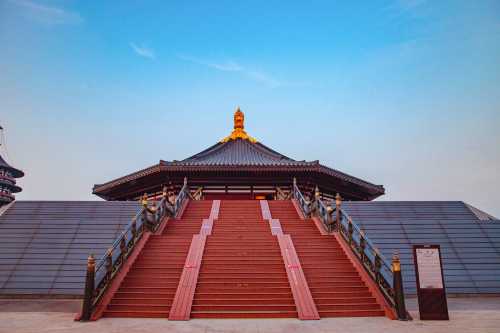Popular Trip Moments
Luoyang Zhimu Mountain Collection: Creating a Poetic Retreat in the Mountains | Wanxiang Shengong—Tiantan Mingtang | Journey to Mount Laojun—The Story of Laozi and Mount Laojun | Treasure Guesthouse Next to Luoyang Yingtianmen Gate | Luoyang! Newly opened! One-bedroom with private hot spring! Amazing | Avoid the crowds and discover the poetic tranquility of Luoyang | I'm on my way to Wangwu Mountain in Jiyuan! | When French romance meets the ancient capital of thirteen dynasties, you'll find it at Mercure | A Must-Stay Hotel in Luoyang | The Gen Z are listening to Chaozhou opera in teahouses to relieve stress? I get it now! | Luoyang's "Little Xinjiang" is here! A free camping treasure! | Luoyang's amazing hotel | "Laojun Mountain: A Fairyland on Earth with Mountains Full of Poetic Charm" | Mehood Lizhi Hotel: A cozy travel base camp is waiting for you! | Luoyang Travel Essential Guide (Comprehensive) | Longmen Grottoes: A Breathtaking and Pride-Inducing Art Gallery Spanning Millennia | The Wonderful Wizard of Oz: The Ultimate Guide to Yuntai Mountain | Hilton Garden Inn Luoyang Kaiyuan Avenue | Luoyang | The hotel you'll never want to check out of! The only one | A great place for a short summer getaway—Luoyang | The Longmen Grottoes | Luoyang Grand Canal Museum: A Courtyard Hotel for the Petite Bourgeoisie | Laojun Mountain Day Trip! The Ultimate Guide is Here!! | Escape the crowds and discover the poetic tranquility of Luoyang | Luoyang Treasure Homestay | Liangyi Liren, an Encounter with the Ancient Charm of the Divine Capital | A Must-Stay in Luoyang! This Homestay is a Photographer's Dream | A trip to Luoyang? The best value for money is the Mehood Liz Hotel | Wow, I really underestimated Luoyang! I'm truly speechless | Luoyang! Yingtianmen Xique Luoshen Hotel | Discover the hidden gem of Luoyang, the Manjing Hotel
Recommended Attractions at Popular Destinations
Bangkok attraction near me | Manila attraction near me | Tokyo attraction near me | Taipei attraction near me | Hong Kong attraction near me | Seoul attraction near me | Kuala Lumpur attraction near me | Los Angeles attraction near me | Shanghai attraction near me | New York attraction near me | Shenzhen attraction near me | Osaka attraction near me | Singapore attraction near me | London attraction near me | Guangzhou attraction near me | San Francisco attraction near me | Beijing attraction near me | Macau attraction near me | Bali attraction near me | Jakarta attraction near me | Paris attraction near me | Ho Chi Minh City attraction near me | Istanbul attraction near me | Phuket attraction near me | Chicago attraction near me | Seattle attraction near me | Toronto attraction near me | Orlando attraction near me | Cebu attraction near me | Chiang Mai attraction near me
Popular Attractions
The Ancient City | KidZania Kuala Lumpur | War Remnants Museum | SHIBUYA SKY | Safari Park Shenzhen | National Museum of Singapore | Chuanlord Tourism & Leisure Expo Garden | Dubai Creek Night Cruise | Palm Jumeirah Monorail | China Harbin Ice And Snow World | Judiaosha | Dubai Miracle Garden | Singapore Zoo | Chengyang Bazhai Scenic Village | Burj Khalifa | Stonehenge | YONA Beach Club Phuket | Soul Beach Saadiyat Island | Maldivian Seaplane Terminal | Mariinsky Theatre | Kamiyuge Road Park | Lesníkova studánka | Lamlifew School of Living Traditions | Parque Pájaro Carpintero | Shakti Maa Temple | Centrale Frontenac | Acer Disc Golf Course | Jarkko Nieminen Arena | Wadworth Street Allotments | Valle dell'Ozola
Popular Restaurants in Luoyang
Luoyang Water Banquet | Shiwei | Xiaojie Tianfu | Dongshanbinguanzhong Restaurant | 国宝铂瑞酒店·麗轩餐厅 | YU GUO DE TIAN TAI | Shizi Street | Tiexielisongzuchuanyangroutangguan | 小气鬼烩菜(老城店) | 大刀面(升龙广场店) | 必胜客(丽新店) | FANG ZHONG SHAN HU LA SHANG LUO YANG DIAN | 海底捞火锅(王府井店) | 海底捞火锅(应天门古城根店) | 四小姐的店(新都汇店) | 遇·花庭里鲜牛肉火锅(西工店) | 海底捞火锅(中州万达店) | 畅享牛排比萨自助(中州路店) | 李想大虾(牡丹路店) | 四小姐的店(青少年宫店) | 洛阳凤翔温泉酒店·丰泽园 | 遇·花庭里鲜牛肉火锅(涧西店) | 海底捞火锅(泉舜店) | Tudalixiuxian Restaurant (taiyuanlu) | DQ(建业凯旋店) | 卡萨米亚·蛋糕面包(万达店) | KA SA MI YA JIAN YI KAI XUAN AN CHANG DIAN | 七日食(万达华阳店) | 丰盛斋(周公路店) | Kasamiya (baolong)
Popular Ranked Lists
Top 3 Best Things to Do in Shuozhou | Popular Best Things to Do in Xinchang | Top 10 Local Restaurants in Zaozhuang | Top 5 Best Things to Do in Tonghua | Top 3 Local Restaurants in Ulanqab | Popular Luxury Hotels in Kieni East | Top 10 Local Restaurants in Xichang | Popular Luxury Hotels in Oslo County | Popular Premium Hotels Near Dearborn | Top 10 Local Restaurants in Wuyishan | Top 4 Best Things to Do in Huanggang | Popular Luxury Hotels in Kathmandu | Popular Luxury Hotels Near Naxos | Popular Local Restaurants in Chongzuo | Top 5 Local Restaurants in Qujing | Popular Trending Restaurants in Shanghai | Popular Luxury Hotels Near Tatsugo | Popular Best Things to Do in Longyou | Top 7 Best Things to Do in Jining | Top 6 Local Restaurants in Anshun | Top 5 Best Things to Do in Xiangshan | Top 4 Local Restaurants in Feixi | Popular Premium Hotels Near Geraldine | Top 9 Best Things to Do in Baishan | Popular Best Things to Do in Zhongxiang | Popular Luxury Hotels Near Recreio dos Bandeirantes | Popular Best Things to Do in Shangqiu | Popular Luxury Hotels Near Century City | Top 10 Local Restaurants in Changxing | Popular Luxury Hotels in Dhofar
Payment Methods
Our Partners
Copyright © 2025 Trip.com Travel Singapore Pte. Ltd. All rights reserved
Site Operator: Trip.com Travel Singapore Pte. Ltd.
Site Operator: Trip.com Travel Singapore Pte. Ltd.











